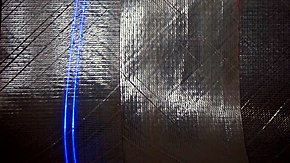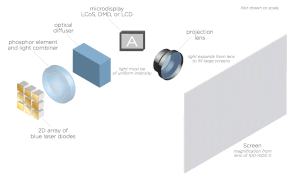Laser projector
Laser projectors is a collective term for some very different devices that use lasers as a light source and project images or patterns.
- Projection of images or videos by scanning a fixed image field and modulating the amplitude of the laser beam. Use in cinemas or planetariums.
- Projection of images by classic video projectors by DMDs or LCDs, in which lasers are used as light sources instead of UPHs or LEDs. Use in cinemas or in home theater.
- Projectors for show effects that can follow any pattern. Use in cinemas, planetariums or open air.
- Industrial laser projectors for projecting auxiliary patterns onto workpieces to be processed. Use in the production process.
A laser projector is a device that projects a constantly changing laser point. This can then be perceived visually (in the entertainment sector) as a complete picture or (in the industrial sector) as a complex pattern. The laser projector consists of the laser source, mirrors, galvanometer and other electronic components. A laser projector can contain a single laser source (of a specific, defined color) or multiple laser sources (e.g. RGB red, green, blue) for full color projection. Furthermore, projectors with a luminescent material that is excited by a (mostly blue) laser and that serves as an approximately point-like white light source are also referred to as laser projectors.
Laser projectors can offer brighter projections with better visibility, especially on projection surfaces made of different materials.
Types of laser projectors
Industrial laser projectors
Industrial laser projectors have been around since 1994. However, they have only been used intensively since around 2002. Industrial laser projectors are mainly used as optical guidance systems. These make it possible to dispense with templates in manufacturing processes, as they indicate the correct position directly on the workpiece to be processed, e.g. B. for welding and assembly or as an optical aid in so-called light guide systems. The workers are visually guided through the work processes.
Advantages of a laser projector
- Fast and stable projection with a high repetition rate
- Optimized for 2D and 3D applications
- Highly accurate projection in the thousandth of a millimeter range
- Large optical angle (80 ° × 80 °) allow large working areas
- Laser projectors can be combined into multi-projection systems, so large and very complex projections are possible (e.g. shipbuilding, wind turbine construction for wind turbines, and much more)
- Material and time savings through optimized work processes
- Direct visual quality control
- Increase in productivity
Industries
- Wind blades for wind turbines
- Assembly support and product control in 3D
- Composite material bonding
- Ship and boat building
- Caravan construction
- Gluing tables - CNC-BAZ - rip saws (stair construction)
- Nail connections (e.g. in roof construction)
- Paper manufacture and processing
- Wiring harness construction
- Aerospace
- Leather nesting
- CNC machine centers
- Alignment of steel plates and slabs e.g. B. in steel mills
- Non-contact inspection of various surfaces
- Concrete industry for the production of prefabricated elements such as stairs, walls, ceilings, etc.
Depending on the material used, different colors can be used for improved visibility.
Laser projection in the cinema
A first laser projector was installed in a Beijing cinema in 2008 . Kodak presented its first laser projector in a US movie theater in 2010. In Germany, the first laser projector was installed in the Cineplex in Penzing in 2014 , and IMAX in Germany is already available with laser projection.
Consumer electronics
Laser projectors for color projection in the entertainment electronics sector have been around since around 2015. The older technology uses high- pressure mercury lamps as the light source . They usually only last a few thousand hours, and replacement bulbs cost between 70 and several hundred euros, depending on the model. The lifespan of laser light sources with phosphorescent luminescent materials is significantly longer; Epson calls for example a lifespan of the laser light source of 30,000 hours for its LS10000 model . The images are usually brighter and the devices are ready for use without warming up or cooling down times, but the power consumption during operation can be higher than that of devices with high- pressure mercury lamps.
Typical components
- Laser diodes (direct injection)
- Red: 635 nm, 638 nm, 642 nm, 650 nm, 660 nm
- Green: 515 nm, 520 nm
- Blue: 445 nm
- Violet: 405 nm
- Solid State DPSS (Diode-Pumped, Frequency-Doubled)
- Red: 671 nm
- Green: 532 nm
- Blue: 473 nm, 457 nm
- Gas laser
- Red: HeNe (Helium-Neon) @ 632.8 nm, Krypton @ 647.1 nm
- Green: argon @ 514.5 nm
- Blue: argon @ 488 nm, 457.9 nm
- Multi-color (white light): gas mixture argon / krypton 647.1 nm, 514.5 nm, 488 nm, 476.5 nm, 457.9 nm
Web links
- Three colors homemade laser projector with ATMega64 controller (RGB division with ATMega64 microcontroller for self-made laser projector) (English)
- Home Built Laser Projector (English)
- Z-LASER - Laser projectors for the composite industry
- Laser Illuminated Projector Association - The Differences: Lamp vs. Laser Illuminated Projectors
Individual evidence
- ↑ a b Beamer in the test: 10 of 15 are good - but only when it's dark , test.de from May 31, 2018, accessed on July 4, 2018
- ↑ Jan-Keno Janssen: Beijing cinema installs first laser projector. In: heise.de. July 22, 2008. Retrieved September 28, 2017 .
- ↑ Georg Immich: Kodak brings laser projectors into digital cinema. In: heise.de. September 30, 2010, accessed September 28, 2017 .
- ↑ Dominic Wimmer: Entertainment: Dracula spreads fear and terror with a laser. In: augsburger-allgemeine.de. Augsburger Allgemeine , October 15, 2014, accessed on September 28, 2017 .
- ↑ What is IMAX 3D Laser 4k? ( Memento of the original of July 28, 2017 in the Internet Archive ) Info: The archive link was automatically inserted and not yet checked. Please check the original and archive link according to the instructions and then remove this notice. In: technik-museum.de , accessed on September 29, 2017.
- ↑ Why lasers are the future of projectors CNET




